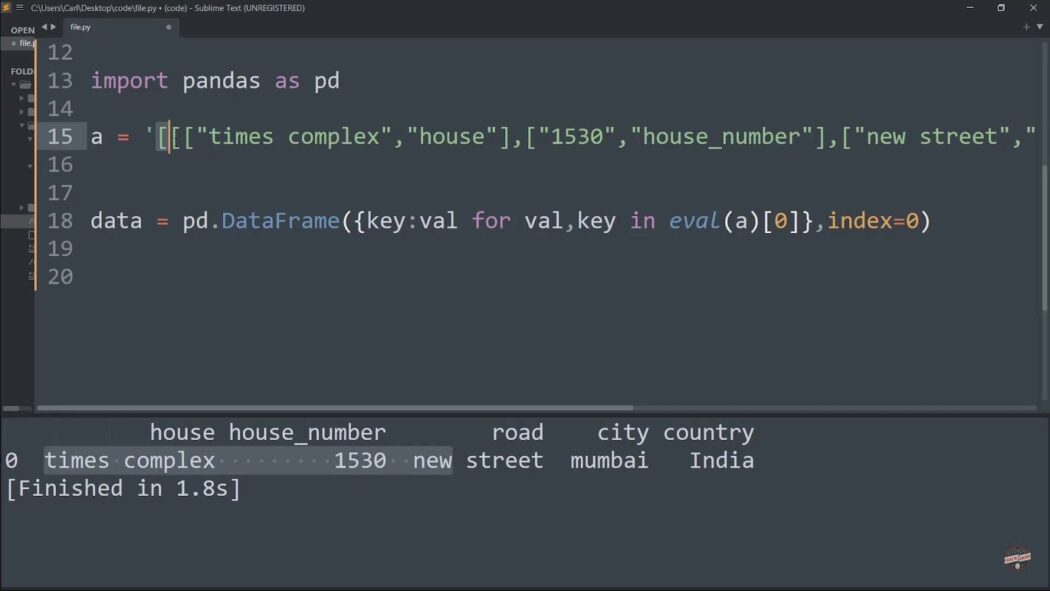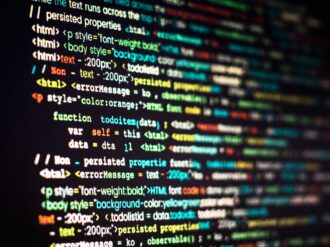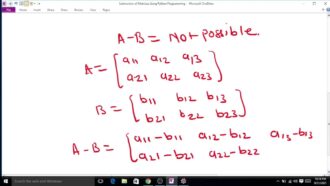
Python: Transforming JSON into DataFrames Made Easy
In today’s data-driven world, handling data in various formats is an essential skill for every data professional and Python enthusiast. JSON (JavaScript Object Notation) has become a ubiquitous data interchange format due to its simplicity and flexibility. On the other hand, Pandas, the popular data manipulation library in Python, provides powerful tools for data analysis and manipulation. When you combine the versatility of JSON with the data-wrangling capabilities of Pandas, you open up a world of possibilities for working with structured data.
In this article, we will delve into the process of converting it step by step. Whether you are extracting data from web APIs, reading files, or working with data received in JSON format, understanding how to seamlessly transform it into a Pandas DataFrame is a valuable skill. We will explore various methods and techniques, from reading JSON files to handling nested structures and dealing with different data complexities.
So, if you’re ready to unlock the potential of your data and harness the analytical power of Pandas, let’s dive into the intricacies of converting.
Unlocking the Power of Data
In the ever-evolving realm of data science, every meaningful journey commences with a crucial step: accessing and interpreting data accurately. This pivotal process sets the stage for the exploration, analysis, and generation of insights. In this guide, we’re going to unravel the art of transforming JSON data, a versatile and widely-used data format, into the Pandas DataFrame within the Python ecosystem. Buckle up as we embark on a journey that promises to equip you with the essential skills to effortlessly convert making your data manipulation endeavors a breeze.
1. The Significance of JSON in Data Science
Before delving into the conversion process, let’s explore why it has become the go-to choice for data scientists in various projects. It offers several compelling advantages:
- Data Diversity: JSON accommodates diverse data types, including strings, numbers, objects, arrays, and more. This flexibility makes it ideal for handling complex datasets;
- Interoperability: widely supported by programming languages, making it easy to exchange data between systems regardless of their technological stack;
- Human-Readable: Its structure is human-readable, aiding in the debugging process and fostering collaboration among team members;
- API Friendliness: preferred format for many APIs, enabling seamless data retrieval and integration from a plethora of sources.
2. The Python-Pandas Synergy
Python, renowned for its simplicity and versatility, is the preferred language for data manipulation. Within the Python ecosystem, Pandas shines as the go-to library for data analysis and manipulation. Before we dive into the conversion process, let’s understand why Python and Pandas make an unbeatable duo:
- Python’s Elegance: its clean syntax and readability are a boon for data scientists. It simplifies code development and debugging, making it the ideal choice for data-centric tasks;
- Pandas’ Power: Pandas is a game-changer when it comes to data manipulation. It introduces data structures like DataFrames, which are akin to tables in databases, making it seamless to work with structured data.
3. Preparing Your Python Environment
Before we start converting JSON to a Pandas DataFrame, you need to ensure your Python environment is equipped with the necessary tools. Here are the steps:
a. Installing
If Pandas isn’t already installed, follow these steps to get it up and running in your environment:
- Open your Command Prompt (Windows) or Terminal (macOS/Linux);
- Run the following command:
pip install pandasb. Verifying Version
It’s crucial to have Pandas version 1.0.3 or higher for this conversion process. To check your version, follow these steps:
In your Python environment, import Pandas:
import pandas as pdThen, print the Pandas version:
print(pd.__version__)c. Updating Pandas (if necessary)
If your version falls short of 1.0.3, don’t worry; it’s easy to upgrade. Use the following command in your Command Prompt or Terminal:
pip install --upgrade pandasCrafting Sample JSON Files for Data Analysis
To illustrate how to work with structures and their conversion this guide will walk readers through the creation of two distinct JSON files. These files, once generated, can serve as a foundation for further exploration in the realms of data analysis, processing, or migration.
1. Basic Structure
The first file we’ll delve into is characterized by its simplicity. This structure contains fundamental user information without nested elements. Here’s how this layout appears:

[
{
"userId": 1,
"firstName": "Jake",
"lastName": "Taylor",
"phoneNumber": "123456",
"emailAddress": "john.smith@example.com"
},
{
"userId": 2,
"firstName": "Brandon",
"lastName": "Glover",
"phoneNumber": "123456",
"emailAddress": "brandon.glover@example.com"
}
]To keep everything organized and accessible, it’s recommended to save this file under the name sample.json, ideally situated in the same directory where the associated Python scripts reside.
2. Advanced JSON Structure with Nested Elements
For users seeking a more complex data structure, the second example incorporates nested elements, providing a richer context. In addition to the basic user details, this file also presents an embedded structure to store the courses associated with each user. Here’s an illustrative example of this intricate structure:
[
{
"userId": 1,
"firstName": "Jake",
"lastName": "Taylor",
"phoneNumber": "123456",
"emailAddress": "john.smith@example.com",
"courses": {
"course1": "mathematics",
"course2": "physics",
"course3": "engineering"
}
},
{
"userId": 2,
"firstName": "Brandon",
"lastName": "Glover",
"phoneNumber": "123456",
"emailAddress": "brandon.glover@example.com",
"courses": {
"course1": "english",
"course2": "french",
"course3": "sociology"
}
}
]For ease of access and organization, it’s advised to save this file as nested_sample.json. Again, storing it in the same directory as the relevant Python scripts ensures seamless integration during subsequent operations.
In sum, these two sample JSON files, both basic and nested, offer a practical starting point for anyone looking to understand and harness the power of it for data-centric tasks. Whether used for educational purposes or as a foundational step in a broader analytical project, these samples provide a tangible insight into the diverse capabilities of it.
Turning Basic JSON into a DataFrame with Pandas in Python
Thankfully, for those acquainted with Python and Pandas, integrating JSON data into their workflow is straightforward. This powerful data manipulation and analysis library, includes a function called .read_json(). This method allows developers to seamlessly read this file and transform it into a DataFrame, which is essentially a table or a two-dimensional array-like structure.
Here’s a demonstration of this process:
import pandas as pd
# Reading the JSON file into a DataFrame
df = pd.read_json("sample.json")
# Displaying the DataFrame
print(df)When executed, this code fetches the content from sample.json and projects it as a DataFrame, making it easier to manipulate and analyze.
Translating Nested
Sometimes, JSON data structures can be a bit more complex, containing nested elements and deeper hierarchies. For instance, when contrasting nested_sample.json with sample.json, one can discern a new field titled ‘courses’—an array encapsulating multiple values.
For such intricacies, a regular .read_json() might fall short. Instead, there’s the .json_normalize() function, crafted precisely for these scenarios. It tackles semi-structured JSON data and simplifies it into a flatter, table-like structure, ensuring consistency and ease of access.
Here’s a glimpse of how to employ this function:
import pandas as pd
import json
# Opening and reading the nested JSON file
with open('nested_sample.json', 'r') as f:
nested_data = json.loads(f.read())
# Converting the nested JSON to a DataFrame
df_nested = pd.json_normalize(nested_data)
# Showcasing the DataFrame
print(df_nested)By using the above snippet, the structured content within nested_sample.json is rendered into a Pandas DataFrame. This transformation allows users to effectively navigate and manipulate data, even when originally presented in a deeply nested format.
Conclusion
In this informative piece, we have delved into the art of transforming JSON data into a Pandas DataFrame within the Python programming realm. This endeavor involves the adept utilization of both the ‘json’ and ‘pandas’ libraries, facilitating a seamless conversion process.
Should you find yourself curious or inclined to offer valuable insights or refinements, we warmly invite you to share your thoughts in the comments section below.


Average Rating